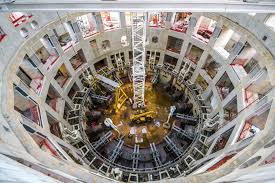
Breaking News
 Trump Halts Five Wind Farms Off the East Coast – 'A major victory for American energy...'
Trump Halts Five Wind Farms Off the East Coast – 'A major victory for American energy...'
 CDC to end animal testing in groundbreaking decision that will impact hundreds of experiments
CDC to end animal testing in groundbreaking decision that will impact hundreds of experiments
 Once-thriving shopping mall in ailing Democrat-run city is eerily empty on last Sunday before...
Once-thriving shopping mall in ailing Democrat-run city is eerily empty on last Sunday before...
 One-of-a-kind trimaran is set to be pedaled around the world
One-of-a-kind trimaran is set to be pedaled around the world
Top Tech News
 Perfect Aircrete, Kitchen Ingredients.
Perfect Aircrete, Kitchen Ingredients.
 Futuristic pixel-raising display lets you feel what's onscreen
Futuristic pixel-raising display lets you feel what's onscreen
 Cutting-Edge Facility Generates Pure Water and Hydrogen Fuel from Seawater for Mere Pennies
Cutting-Edge Facility Generates Pure Water and Hydrogen Fuel from Seawater for Mere Pennies
 This tiny dev board is packed with features for ambitious makers
This tiny dev board is packed with features for ambitious makers
 Scientists Discover Gel to Regrow Tooth Enamel
Scientists Discover Gel to Regrow Tooth Enamel
 Vitamin C and Dandelion Root Killing Cancer Cells -- as Former CDC Director Calls for COVID-19...
Vitamin C and Dandelion Root Killing Cancer Cells -- as Former CDC Director Calls for COVID-19...
 Galactic Brain: US firm plans space-based data centers, power grid to challenge China
Galactic Brain: US firm plans space-based data centers, power grid to challenge China
 A microbial cleanup for glyphosate just earned a patent. Here's why that matters
A microbial cleanup for glyphosate just earned a patent. Here's why that matters
 Japan Breaks Internet Speed Record with 5 Million Times Faster Data Transfer
Japan Breaks Internet Speed Record with 5 Million Times Faster Data Transfer
Building to house world's largest tokamak fusion reactor now complete

Nine years in the making, the facility is built to host the type of super-hot high-speed reactions that take place inside the Sun, and hopefully advance our decades-long pursuit of clean and inexhaustible nuclear fusion energy.
In the works since 1985, ITER (International Thermonuclear Experimental Reactor) is a type of nuclear fusion reactor known as a tokamak and is a collaborative project involving thousands of scientists and engineers from 35 countries. These donut-shaped devices are designed to accommodate circular streams of plasma consisting of hydrogen atoms, which are compressed using superconducting magnets so that they fuse together and release monumental amounts of energy.
There are key technological challenges to overcome when it comes to tokamak reactors. Chiefly, these center on bringing them up to the required temperatures and keeping the streams of plasma in place long enough for the reactions to take place.

 Advanced Propulsion Resources Part 1 of 2
Advanced Propulsion Resources Part 1 of 2

